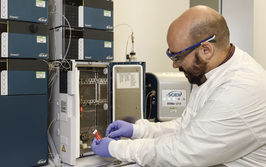Never Break the Chain
How do we prevent criminals from reusing primary packaging for counterfeit medicines? Labeling solutions and other creative concepts can help.
Nadine Lampka | | 5 min read | Opinion

Since the EU’s Falsified Medicines Directive became effective in February 2019, tampering with secondary medicine packaging has become more difficult. But what about primary containers, such as vials, syringes, and autoinjectors?
Illegal medicines inflict considerable damage on the pharmaceutical industry, posing a massive risk to patient safety. Operation Shield III, conducted between April and October 2022 by Europol, the European Agency for Law Enforcement Cooperation, once again revealed the magnitude of this issue. Authorities seized massive amounts of misused, falsified or counterfeit medicines, doping substances, counterfeit COVID-19 vaccines, sanitary products, and medical devices worth over 40 million euros. Twenty eight European countries were involved in the operation and 59 criminal groups were dismantled.
The Falsified Medicines Directive requires pharmaceutical manufacturers to include an individual serial 2D code (data matrix) on the secondary packaging of prescription drugs, as well as tamper-evident feature, such as a closure seal that indicates the integrity of packaging. Special folding box designs, glue dots, and various seal solutions with irreversible void-effects have all become established as reliable first-opening indicators.
In some healthcare settings, however, secondary packaging materials may be disposed of and the primary containers stored elsewhere until the medicines are dispensed. An integrity check of the container prior to its first use would be essential in this case — but the EU Directive only addresses secondary packaging.
Counterfeiters have been known to search for empty, original medicine bottles or vials in waste containers, refill them with counterfeit substitutes and sell them as supposed originals. Thus, to achieve comprehensive product and patient safety as the result of a consistently secured supply chain, appropriate security solutions should also be implemented for primary packaging.
Various security concepts exist to help ensure the integrity of primary containers. For glass vials, for example, a security label can be wrapped around the vial up to the level of the cap. Before opening, a tear strip has to be peeled off, which indicates that the label has been opened, and a covert warning message becomes visible. The first-opening indication can also be further enhanced by an optional void effect, where previously invisible lettering or symbols irreversibly separate from an indicator field. Afterwards, it is no longer possible to unnoticeably reuse the container. This type of tamper-evident label is suited particularly for small vials and can be equipped with an inspection window. Special labeling materials are also usually available that can protect the medicine in the container against UV or other light rays by selecting a special label material.
Label-based sealing solutions with first-opening indication can also be used for prefilled syringes. For example, a specialty label that wraps around the entire cap and syringe barrel can secure the integrity of the syringe until the injection is performed. Opening the label activates a first-opening indication and special security die-cuts result in partial destruction of the label to prevent reclosing. Covert warning messages can also be added.
Another example for luer-lock syringes is a label plus cap. Initially, the differences between the radii of the syringe body and the closure cap are equalized by means of a special cap adapter placed on top of the syringe closure. Subsequently, a label with an integrated perforation for tamper evidence is applied to the syringe body and cap adapter so that it firmly wraps around both elements. Since the adapter interlocks with the original closure of the cap, the syringe can be opened in a single move as usual. This purposefully destroys the label, which thus clearly and irreversibly indicates that the syringe has been opened. The larger circumference of the adapter compared with the original syringe closure makes it easier for the user to open the cap. In addition, this concept helps ensure the sterility and integrity of the luer-lock syringe up until its use.
And what about the autoinjectors used in homecare settings? Self-medication is increasing and patients need to be able to easily and quickly check their injection aids for integrity and authenticity. Near field communication (NFC) chips can be integrated into smart labels, which can be applied to primary containers during production and serve as digital tamper evidence. They can be read using a smartphone app. NFC labels can be applied so that they wrap around the autoinjector, including the cap. Before pulling off the autoinjector cap, the user checks if the product is an original; after reading the chip, the app will show a respective confirmation. After opening the cap and another reading of the chip, a warning message will appear indicating that the product has been opened. If this warning message appears before the patient has opened the device for the first time, this indicates a potential tampering attempt. In addition to the first-opening indicator function, the chip can be also used for further features. For example, pharmaceutical manufacturers may integrate interactive applications, such as product information or demo videos. Geo tracking features can also be added to detect potential gray market activities in local markets.
Both analog and digital security solutions provide comprehensive tamper evidence for primary containers and injection aids, assisting healthcare professionals and patients in readily detecting previously opened containers as part of their daily routines. However, in the context of a secure supply chain, such solutions are inadequate because, in addition to product identity and integrity, the authenticity of a product must be ensured.
In my view, comprehensive protection against counterfeiting and tampering can only be guaranteed by a combination of different features. For instance, analog authentication features, such as holograms, thermo-chromatic effects, or a perforation preventing undetected re-capping, can be integrated into a label in addition to an NFC chip. Ideally, integrated security concepts should combine several security technologies in a multi-layered approach addressing different user groups within the supply chain.
End-to-end supply chain integrity plays a major role for the pharmaceutical industry, by embracing appropriate security concepts, stakeholders can verify both secondary and primary packaging.
Senior Product Manager Pharma-Security, Schreiner MediPharm, Munich



















